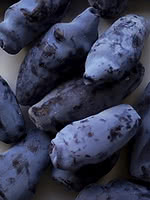Mon-Fri 9am - 5pm Mountain time
Aurora Haskap (Honeyberry) vs Bilberry
Vaccinium myrtillus
Lonicera caerulea Aurora
CUSTOM GROW
Bilberry is a native perennial shrub valued for its small, blue-black berries that ripen in mid to late summer. The berries resemble blueberries but have a richer, more tart, and intense flavor. They have long been used for fresh eating, baking, and preserves, while also providing food for birds and mammals. In spring, its delicate pinkish flowers attract bees and other pollinators.
Growing low to the ground, Bilberry forms spreading colonies that create dense understory cover. This growth habit provides food and shelter for wildlife, and its foliage adds seasonal interest by turning red to purple in autumn. With its adaptability and ecological benefits, Bilberry is well-suited for naturalization, ecological restoration, and pollinator gardens.
Aurora Haskap is considered one of the top Haskap varieties, known for its excellent flavour and lower acidity, resulting in a sweeter taste. The flavour of Haskaps is generally described as a cross between a blueberry and a raspberry. Aurora Haskaps are well suited to fresh eating, freezing, baking, and preserves.
It produces high yields of large berries and the upright growth habit makes it suitable for mechanical harvesting. The berries are easily seen on the bush, making them easy to pick.
For optimal fruit production, cross-pollination is required. Haskaps need to be planted with a compatible variety. Compatibility is influenced by both bloom time and genetics.
Aurora Haskap is an early-pollinating variety and pairs well with Borealis, Tundra, Honey Bee, and Indigo Gem.
Bilberry Quick Facts
Aurora Haskap (Honeyberry) Quick Facts
Toxicity: leaves may be unsafe in high doses

